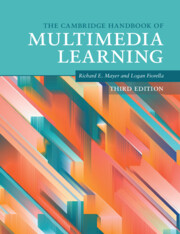Book contents
- The Cambridge Handbook of Multimedia Learning
- The Cambridge Handbook of Multimedia Learning
- Copyright page
- Contents
- Figures
- Tables
- Contributors
- Preface
- Acknowledgments
- Part I Background
- Part II Theoretical Foundations
- Part III Basic Principles of Multimedia Learning
- Part IV Principles for Reducing Extraneous Processing in Multimedia Learning
- 14 Principles for Reducing Extraneous Processing in Multimedia Learning
- 15 The Split-Attention Principle in Multimedia Learning
- 16 The Redundancy Principle in Multimedia Learning
- 17 The Signaling (or Cueing) Principle in Multimedia Learning
- 18 The Worked Example Principle in Multimedia Learning
- Part V Principles for Managing Essential Processing in Multimedia Learning
- Part VI Principles Based on Social and Affective Features of Multimedia Learning
- Part VII Principles Based on Generative Activity in Multimedia Learning
- Part VIII Multimedia Learning with Media
- Author Index
- Subject Index
- References
14 - Principles for Reducing Extraneous Processing in Multimedia Learning
Coherence, Signaling, Redundancy, Spatial Contiguity, and Temporal Contiguity Principles
from Part IV - Principles for Reducing Extraneous Processing in Multimedia Learning
Published online by Cambridge University Press: 19 November 2021
- The Cambridge Handbook of Multimedia Learning
- The Cambridge Handbook of Multimedia Learning
- Copyright page
- Contents
- Figures
- Tables
- Contributors
- Preface
- Acknowledgments
- Part I Background
- Part II Theoretical Foundations
- Part III Basic Principles of Multimedia Learning
- Part IV Principles for Reducing Extraneous Processing in Multimedia Learning
- 14 Principles for Reducing Extraneous Processing in Multimedia Learning
- 15 The Split-Attention Principle in Multimedia Learning
- 16 The Redundancy Principle in Multimedia Learning
- 17 The Signaling (or Cueing) Principle in Multimedia Learning
- 18 The Worked Example Principle in Multimedia Learning
- Part V Principles for Managing Essential Processing in Multimedia Learning
- Part VI Principles Based on Social and Affective Features of Multimedia Learning
- Part VII Principles Based on Generative Activity in Multimedia Learning
- Part VIII Multimedia Learning with Media
- Author Index
- Subject Index
- References
Summary
Extraneous processing occurs when suboptimal instructional design causes learners to engage in cognitive processing irrelevant to the instructional goal. This chapter explores five principles for reducing extraneous processing in multimedia learning: coherence, signaling, redundancy, spatial contiguity, and temporal contiguity. The coherence principle is that people learn better when extraneous information is excluded from multimedia lessons. The signaling principle is that people learn better when cues are added to highlight the organization of the essential information. The redundancy principle is that people learn better when multimedia lessons include graphics and spoken text rather than graphics, spoken text, and printed text. The spatial contiguity principle is that people learn better when words and corresponding graphics are physically integrated rather than separated. The temporal contiguity principle is that people learn better when words and corresponding graphics are presented simultaneously rather than sequentially.
Keywords
- Type
- Chapter
- Information
- The Cambridge Handbook of Multimedia Learning , pp. 185 - 198Publisher: Cambridge University PressPrint publication year: 2021
References
- 11
- Cited by



